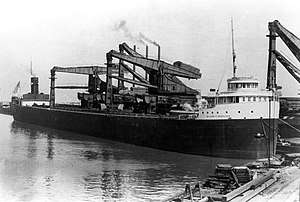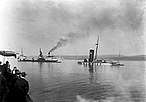SS William C. Moreland
SS William C. Moreland was a 600-foot (180 m) long Great Lakes freighter that ran aground on Sawtooth Reef, Lake Superior on 18 October 1910, only a month after entering service.[1]
 William C. Moreland before she sank | |
| History | |
|---|---|
| Name: | |
| Operator: | Interstate Steamship Company (Jones and Laughlin Steel Company) (W.H. Becker, Mgr.) |
| Port of registry: |
|
| Builder: | American Ship Building Company, Lorain, Ohio |
| Yard number: | 387 |
| Launched: | 27 July 1910 |
| Maiden voyage: | 1 September 1910 |
| In service: | 6 September 1910 |
| Out of service: | 18 October 1910 |
| Identification: | U.S. Registry #207851 |
| Fate: | Ran aground and wrecked on Sawtooth Reef on 18 October 1910 |
| General characteristics | |
| Type: | Bulk freighter |
| Tonnage: | |
| Length: | |
| Beam: | 58 ft (18 m) |
| Height: | 32 ft (9.8 m) |
| Installed power: | 2 x Scotch marine boilers |
| Propulsion: | 2,000 hp (1,500 kW) triple expansion steam engine attached to a single fixed pitch propeller |
| Speed: | 11 knots (20 km/h; 13 mph) |
| Capacity: | 12.000 tons |
| Crew: | 25 |
The crew could not see a thing because of smoke from several forest fires, due to this William C. Moreland ran full steam on to the reef. There were many attempts to salvage the ship, but eventually only the 278-foot (85 m) long stern was salvaged and was used to build the 580-foot (180 m) long Sir Trevor Dawson.[2][3][4]
Sir Trevor Dawson was christened on 18 October 1916, exactly six years after William C. Moreland wrecked. Sir Trevor Dawson continued to sail for fifty-four years until she was scrapped in 1970, in Spain as the steamer Parkdale.[5]
History
In 1906 the Jones and Laughlin Steel Company commissioned two 552-foot (168 m) long freighters named B.F. Jones and James Laughlin both named after the company's founders, and both built by the Great Lakes Engineering Works (GLEW) of Ecorse, Michigan.[6] The large fleet was managed by W.H. Becker, a prominent fleet manager and owner from Cleveland, Ohio.[7]


Due to the increasing demand for iron ore Jones and Laughlin Steel Company commissioned two identical vessels; William C. Moreland from American Shipbuilding Company (AMSHIP) and Willis L. King from GLEW. They were identical in every respect and had a length of 600 feet (180 m) and a 12.000 cargo capacity.
It was reported that William C. Moreland was the last launching of the year at AMSHIP's Lorain, Ohio yard. Miss Esther Moreland of Pittsburgh christened the new vessel. She was the niece of the vessel's namesake, a prominent Pittsburgh attorney who was a vice-president and secretary of Jones and Laughlin Steel Company.
On August 23, 1910 William C. Moreland was temporarily enrolled at Cleveland, Ohio and assigned a U.S. official identification number U.S. #207851 for delivery to Jones and Laughlin's Interstate Steamship Company fleet. William C. Moreland cost nearly $450,000, she was 600 feet in overall length (580 feet, 180 m between perpendiculars) with a beam of 58 feet (18 m) feet and a depth of 32 feet (9.8 m) feet and measured at 7,514 gross register tons and 5,803 net register tons. The she was powered by a 2,000-horsepower (1,500 kW) triple-expansion steam engine and fueled by two coal-fired Scotch marine boilers. She had an arch frame construction and three cargo holds with 36 cargo hatches placed on 12-foot (3.7 m) centers. William C. Moreland was Jones and Laughlin's largest ship at the time of her construction. William C. Moreland usually carried coal when she was upbound and iron ore when she was downbound.


Final voyage
On her fifth trip William C. Moreland left Superior, Wisconsin during the early hours October 18, 1910 with 10,700 tons of iron ore bound for Ashtabula, Ohio. The weather on Lake Superior was relatively mild with little or no wind or wave action, but visibility was hampered by smoke coming from several forest fires burning on the Keweenaw Peninsula in Michigan's Upper Peninsula. Vast stretches of brush and forests were burning on the peninsula due to drought-like conditions in the area causing severe visibility problems. Approaching the Keweenaw Peninsula about 17 hours after she left port the first mate, unsure of William C. Moreland's position sighted an unidentified beam of white light. He called Captain Claude Ennes to the bridge at about 9:00 at night. A few minutes later William C. Moreland ran aground Sawtooth Reef.
Salvage efforts
The hull of William C. Moreland remained intact until October 20, 1910 when the ship broke in two between the tenth and eleventh hatch due to the pressure the hull was under.[8] Further cracking occurred near hatch 23 due to the enormous strain put on the hull by the flooded and loaded cargo holds and the unsupported midsection.[9] The salvage rights were eventually sold to the Reid Wrecking Company of Sarnia, Ontario. The Reid Wrecking Company managed to salvage the 278-foot (85 m)-long stern of the ship, the 302-foot (92 m)-long bow stayed on the reef until it slid off and sank. The stern was reused as part of Sir Trevor Dawson.[10]
On March 25, 1911, American Shipbuilding Company launched the 605-foot (184 m)-long freighter Thomas Walters which was ordered by the Jones and Laughlin Steel Company to replace William C. Moreland. Thomas Walters sailed until 1984 when she was scrapped in Ashtabula, Ohio.[11]
William C. Moreland wreck
The remains of William C. Moreland rest in 25 to 40 feet (7.6 to 12.2 m) of water.[12] The wreck has been largely flattened by years of ice and wave action, but the there is still a lot of machinery, and numerous pieces of her hull left on the wreck site. William C. Moreland's wreck is part of the Keweenaw Underwater Preserve.
References
- "AmShip Lorain". Shipbuilding History. Retrieved 20 January 2018.
- "Moreland, William C." Bowling State Green University. Retrieved 20 January 2018.
- "American Steel Barge, Superior WI". Shipbuilding History. Retrieved 31 January 2018.
- "William C. Moreland 214499 (Canada 316355)". OhioLINK. Retrieved 31 January 2018.
- "Moreland, William C." Great Lakes Vessel History. Retrieved 7 January 2018.
- "Jones And Laughlin Steel Corporation (The Interstate Steamship Co.)". The Scanner. Retrieved 31 January 2018.
- "Great Lakes Ships To Be Remembered No.35 William C. Moreland" (PDF). Mshd.org. Retrieved 20 January 2018.
- "William C. Moreland". Flickr. Retrieved 13 February 2018.
- Jennifer Billock (2014). Keweenaw County. Arcadia Publishing. p. 91. ISBN 978-1-4671-1123-2.
- "William C. Moreland". ship-wrecks.net. Archived from the original on 22 December 2017. Retrieved 7 January 2018.
- "Walters, Thomas". Great Lakes Vessel History. Retrieved 15 February 2018.
- "SS William C. Moreland (Bow) (+1910)". Wrecksite. Retrieved 12 December 2017.